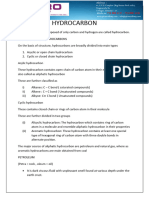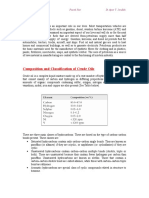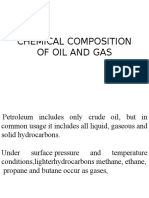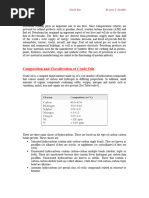0 ratings0% found this document useful (0 votes)
6 viewsPetroleum Properties: Dr. Hanoon H. Mashkoor & Asst. Lect. Maryam J. Jaafar
Petroleum Properties: Dr. Hanoon H. Mashkoor & Asst. Lect. Maryam J. Jaafar
Uploaded by
MṜ ΛßßΛSPetroleum, also known as crude oil, is a naturally occurring fossil fuel found underground that is formed from the remains of ancient plants and animals. It is composed primarily of hydrocarbons like paraffins, naphthenes, and aromatics, along with small amounts of sulfur, oxygen, and nitrogen. The two main theories for the origin of petroleum are the organic theory which states it formed from decaying organic matter, and the inorganic theory which proposes it comes from primordial hydrocarbons deep in the earth's crust.
Copyright:
© All Rights Reserved
Available Formats
Download as PDF, TXT or read online from Scribd
Petroleum Properties: Dr. Hanoon H. Mashkoor & Asst. Lect. Maryam J. Jaafar
Petroleum Properties: Dr. Hanoon H. Mashkoor & Asst. Lect. Maryam J. Jaafar
Uploaded by
MṜ ΛßßΛS0 ratings0% found this document useful (0 votes)
6 views21 pagesPetroleum, also known as crude oil, is a naturally occurring fossil fuel found underground that is formed from the remains of ancient plants and animals. It is composed primarily of hydrocarbons like paraffins, naphthenes, and aromatics, along with small amounts of sulfur, oxygen, and nitrogen. The two main theories for the origin of petroleum are the organic theory which states it formed from decaying organic matter, and the inorganic theory which proposes it comes from primordial hydrocarbons deep in the earth's crust.
Original Description:
خواص النفط المحاضرة 1
Original Title
1
Copyright
© © All Rights Reserved
Available Formats
PDF, TXT or read online from Scribd
Share this document
Did you find this document useful?
Is this content inappropriate?
Petroleum, also known as crude oil, is a naturally occurring fossil fuel found underground that is formed from the remains of ancient plants and animals. It is composed primarily of hydrocarbons like paraffins, naphthenes, and aromatics, along with small amounts of sulfur, oxygen, and nitrogen. The two main theories for the origin of petroleum are the organic theory which states it formed from decaying organic matter, and the inorganic theory which proposes it comes from primordial hydrocarbons deep in the earth's crust.
Copyright:
© All Rights Reserved
Available Formats
Download as PDF, TXT or read online from Scribd
Download as pdf or txt
0 ratings0% found this document useful (0 votes)
6 views21 pagesPetroleum Properties: Dr. Hanoon H. Mashkoor & Asst. Lect. Maryam J. Jaafar
Petroleum Properties: Dr. Hanoon H. Mashkoor & Asst. Lect. Maryam J. Jaafar
Uploaded by
MṜ ΛßßΛSPetroleum, also known as crude oil, is a naturally occurring fossil fuel found underground that is formed from the remains of ancient plants and animals. It is composed primarily of hydrocarbons like paraffins, naphthenes, and aromatics, along with small amounts of sulfur, oxygen, and nitrogen. The two main theories for the origin of petroleum are the organic theory which states it formed from decaying organic matter, and the inorganic theory which proposes it comes from primordial hydrocarbons deep in the earth's crust.
Copyright:
© All Rights Reserved
Available Formats
Download as PDF, TXT or read online from Scribd
Download as pdf or txt
You are on page 1of 21
Petroleum
properties
Dr. Hanoon H. Mashkoor &
Asst. Lect. Maryam J. Jaafar
What is Petroleum?
• The word petroleum originated from the Latin words,
Petra, meaning rock and oleum, meaning oil. Literally it
means ‘Rock Oil,’ and can also be defined as a non-
renewable fossil fuel or oil that is found underground.
This is any naturally-occurring flammable mixture of
hydrocarbons found in geological formations such as rock
strata.
• Technically, the term petroleum refers to describe any
solid, liquid or gaseous hydrocarbons. It’s also known as
‘crude oil’ or ‘mineral oil.’
Occurrence of Petroleum
• Petroleum occurs in the earth’s crust, in all possible states
and varies in color from light brown to dark brown or
black, exhibiting luminescence in some cases. It is a
mixture of various hydrocarbons, of homologous series
namely paraffins, napthenes and aromatics.
• The final result is a black viscous product of composition:
• Carbon 80 to 89%
• Hydrogen 12 to 14%
• Nitrogen 0.3 to 1 %
• Sulphur 0.3 to 3%
• Oxygen 2 to 3%
Petroleum Formation.
There are basically two theories explaining the origin of oil,
1-Organic Theory (Biotic Theory)
• Oil developed millions of years from organic material remains of dead plants and
animals (algae and planktons).
• The dead organisms sank to the bottom of water bodies (seas and lakes), where
the environment tends to be anaerobic.
• They accumulated in the mud on the beds of the water bodies, partially
decomposed.
• Sediment deposition on the bed of the water body, burying and compressing the
organic matter under its weight.
• Increase in temperatures(100-160°c) and pressures resulted due to continued
sediment deposition.
• With time the conditions broke down the organic compounds into shorter
hydrocarbon chains, forming oil and natural gas.
• Oil and natural gas flowed from the source rock, accumulating in thicker more
porous rock called a reservoir rock.
• Earth movements (faulting, folding ) trapped the oil and natural gas in the
reservoir rock between layers of impermeable rock or cap rock also called an oil
trap.
2.Inorganic Basis Theory Or Metallic Theory
• This hypothesis of petroleum origin without biology was
first proposed in 16th century by Georg Agricola, then in
19th century by Alexander (Prussian geographer), Dmitri
(Russian chemist), Marceline (French chemist) and re-
defined in 20th century by Cornell University physicist,
Thomas Gold.
• The theory argued that petroleum originated from
limitless pools of liquid primordial hydrocarbons at great
depths in the earth.
• These carbon-bearing fluids migrated upward from the
mantle where they slowly replenish the reservoirs that
conventional oil drillers tap.
• The most important Iraqi oil fields
1. The Rumaila oil field
2. Majnoon oil field
3. Al-Zubair oil field
4. West Qurna oil field
5. Luhais (bpd)
6. Nahr Bin Omar
7. Nassiriya (bpd)
8. Gharraf (bpd)
9. East Missan fields (Buzurgan, Fakka, Abu Gharb)
10. Halfaya (bpd)
11. Badra
12. East Baghdad + Naft Khana
13. Eastern Kirkuk (Baba, Jambour, Khabbaz)
14. Western Kirkuk (Bai Hassan and Avana)
15. Qayarah
• Composition of Petroleum
Petroleum occurs in nature in all three possible states solid,
liquid and gas. The liquid petroleum is usually colored from
dark brown to bluish black or black, exhibiting sometimes
bloom or fluorescence. The semi-solid or solid petroleum is
well known by the name pitch, usually black in color. Such
kind of deposits ate assumed to form after the evaporation
or migration of lighter fractions.
• The average ultimate composition of petroleum is mainly
given in terms of constituents of hydrocarbons, namely
carbon and hydrogen as follows :
• Carbon 84—86%
• Hydrogen 11—14%
• The other major elements of importance are sulfur,
oxygen and nitrogen. These elements in hydrocarbons are
usually treated as impurities because of their inherent
properties like odor, color corrosiveness etc. Generally
these three elements combined, do not exceed 5% on an
average.
• Paraffins :
• CnH2n+2 is the general formula of paraffins. First three compounds are
gases while compounds upto C16 are liquids and beyond that, they
assume semisolid consistency. Well beyond C30 assume shape of solid
blocks, sometimes even crystalline forms. There are number of isomeric
compounds for each compound, profoundly differing in properties. For
example up to C3 no isomers are possible, C4 exhibits only two isomers,
as shown here :
• And C5 exhibits three isomers. The number of isomers increases as the
number of carbon atoms increase C13H28 exhibits 802 isomeric forms.
• General properties of paraffins
• Paraffins are stable, not attacked by sulfuric acid or other oxidizing
agents. However, paraffins of higher order > C30 are prone to oxidation.
Even usual oxidizing agents like potassium permanganate can cause
good amount of oxidation. The aptitude to contribute the substituted
products with halogens has magnified the petrochemical industry. Higher
paraffins are very much insoluble in water ; though the lower ones are
soluble in ethers and alcohols. Paraffins up to 3 carbon atoms have
inclination to form hydrates such as [CH4.7H2O, C2H6. 7H2O] and
these hydrates offer clogging and corrosion difficulties. Hence drying is
essential before usage.
• Naphthenes
• These are saturated ring compounds bearing the general
formula CnH2n. The prominence of ring structure starts with
five carbon atoms. Although C3 and C4 ring structures, are in
existence, their stability is decreased because of excessive
strain (Bayer’s Strain, Theory). Naphthenes are isomeric with
olefins but differ profoundly in properties.. Naphthenes exhibit
both the properties of saturated paraffins and unsaturated
aromatics, the result of which, all the properties like sp.
gravity, viscosity, pour point, thermal characteristics lie in
between the two mentioned homologues. Usually, all the ring
structures are having branched chains, where the isomeric
character predominantly occurs, followed by positional
isomerism in rings
• Aromatics
The first and smallest of the aromatics is benzene; other simple
aromatics to follow are toluene, xylene, cumene etc. Even though
benzene is unsaturated, yet it follows the principles of
substitution with halogens rather than addition. This is mainly
due to symmetric grouping of closed ring structure and resonance
.Aromatics are usually having high boiling points, low pour
points (freezing points), high octane numbers, high viscosity and
low viscosity index and these bum characteristically with a red
flame with much soot. As these behave like saturates, they resist
oxidation. In petroleum fractions aromatics beyond 3-ring
structure (Anthracenes) are probably non-existent. Aromatics
usually extend their presence from a temperature of 80° C
onwards and well dominate, in lower middle cuts and heavy cuts.
Actually the light aromatics (BTX) do not exceed even 5% of
crudes of general nature. Bulk of the aromatics are with side
chains and naphthenes and exist in heavier portion of crudes.
• Inorganics
• Sulfur compounds: Sulfur is found in most of the crudes in variable amounts.
Generally sulfur compounds are present in more quantities in higher molecular
weight stocks. Usually the sulfur content does not exceed 5%, however rare
exemptions are : Venezuela (5.25%), California (USA 5.21%), Qaiyarah (Iraq—
7%) etc. crudes.
• Sulfur in crude occurs in different forms (like free sulfur, hydrogen sulfide,
mercaptans and thiophenes etc. These are frequently occuring compounds in almost
all fractions of the crude though to a different degree. Heavier fractions contain
sulfides, polysulfide, sulfonates and sulfates.
• Sulfur occupies prominent position in refining due to its ominous problems of
corrosion and odor. Pollution problems and following cost of waste treatment is
punitive for all refiners with high sulfur-stocks. However, refiners habitually
remove more detrimental sulfur compounds and leave the less harmful ones into
the products, as seen in the case of sulfides converted to disulfides in gasolines.
Some of the sulfonates are regarded as good emulsifiers and detergents, hence
promptly extracted for use in cutting oils. Conspicuous effect of sulfur is reflected
in increasing the density of crude.
• A correlation presented by Obolentsev shows the influence of sulfur on gravity
• ρ at 20C =0.0087 (S%)2+0.0607(S%)+0.7857
• Different crudes are presented in following table. It clearly shows the effect of
sulfur on API gravity of crude and pour point of crude. All sulfur crudes
mysteriously exhibit low pour points.
• Further, sulfur containing residuum when cracked leaves cross
linked structures, resembling the phenomenon of vulcanization
of rubber and offer perennial problems in desulfurization. Its
presence in different fractions complicates the refining and
treatment methods. Yet another problem is, it desists the effects
of additives. Sulfur in gasoline inevitably depresses the effect
of lead and demands more amount of additive. When crude
contains more than 0.5% S, it is denoted as high sulfur crude.
A terse distinction, at this juncture between sour crudes and
sulfur crudes is desirable. Free hydrogen sulfide is available in
some crudes, which naturally fosters corrosion. Such crudes
are classified as sour crudes ; other sulfur bearing compounds
are not taken into this account. The crudes containing sulfur
compounds other than hydrogen sulfide and exceeding 0.5 %
are denoted as high sulfur crudes
• Oxygen
Oxygen and nitrogen do not occur in free state either in
crudes or in fractions. Nitrogen presence in free form is
well known in natural gas only. Oxygen occurs as
oxygenated compounds like phenols, cresols, naphthenic
acids, sulphonates, sulfates and sulfoxides
• Nitrogen
Nitrogen exists in the form of indoles, pyridines, quinolines and
amines, usually well below 2%. Nitrogen compounds exasperate
problems in processing and stability of products. Catalyst deactivation
or poisoning, gum formation are some of the offshoots of nitrogen.
Nitrogen is present in two forms, basic and non-basic. Basic nitrogen is
characterized by its titratability with perchloric acids, whereas nonbasic
nitrogen is not titratable hence no possibility of extraction. Most of the
nitrogen pigments impart color to crude and fractions. The most
interesting compounds of nitrogen are porphyrins. These are obtained
from living organisms and preserved in petroleum. It stands to reason
that anaerobic conditions were prevailing durring petroleum formation;
otherwise oxidation would have destroyed them. Chlorophyll is also a
complex of porphyrins, where central atom is magnesium instead of
nickel or vanadium or iron. Iron porphyrins are also known as heme, the
constituents of red cell in the blood. Porphyrins pigments are usually
associated in complex form with metals like, copper, iron, vanadium
and nickel. The proper understanding of these pigments may augment
the knowledge of origin and formation of petroleum.
• There are other compounds such as
• Organometalic Compounds.
• Insoluble Impurities.
You might also like
- 02 Class 6 Worksheet Alien DNADocument2 pages02 Class 6 Worksheet Alien DNANathan MonsonNo ratings yet
- Tennessee Eastman Acetic Anhydride Process LL Organometallic ChemistryDocument2 pagesTennessee Eastman Acetic Anhydride Process LL Organometallic ChemistryfarshidNo ratings yet
- Phase Behavior NotesDocument132 pagesPhase Behavior NotesMuhammad NursalamNo ratings yet
- Properties of Petroleum ProductsDocument30 pagesProperties of Petroleum ProductsBharath KumarNo ratings yet
- Chemistry-Of-Oil-GasDocument15 pagesChemistry-Of-Oil-Gasgarmian taibNo ratings yet
- 1-Chapter1 Origin & HC propertiesDocument73 pages1-Chapter1 Origin & HC propertiestamngo2206No ratings yet
- Chemical Composition of PetroleumDocument111 pagesChemical Composition of PetroleumAnonymous iCFJ73OMpDNo ratings yet
- Crude Oil: PetroleumDocument10 pagesCrude Oil: Petroleumstnb9m28p9No ratings yet
- Chemistry and Technology of PetroleumDocument20 pagesChemistry and Technology of PetroleumNafis AdnanNo ratings yet
- Lec. 1 Chemicals From Petroleum 2021-01-31 at 5.02.32 PM 2 2021-04-13 at 9.04.02 PMDocument154 pagesLec. 1 Chemicals From Petroleum 2021-01-31 at 5.02.32 PM 2 2021-04-13 at 9.04.02 PMMuntazer QasimNo ratings yet
- This Chapter Includes Data About Petroleum and Corrosion in GeneralDocument25 pagesThis Chapter Includes Data About Petroleum and Corrosion in GeneralFadzli KhirNo ratings yet
- PetroleumDocument9 pagesPetroleumowegibrian479No ratings yet
- PetroleumDocument54 pagesPetroleumJthan ReyesNo ratings yet
- Composition of PetroleumDocument17 pagesComposition of PetroleumAleem Ahmed100% (1)
- Chapter 1 Crude Oil DistillationDocument25 pagesChapter 1 Crude Oil DistillationAbdul QayyumNo ratings yet
- Study Corrosive SulphurDocument15 pagesStudy Corrosive SulphurSamsudin Ahmad100% (1)
- The Role of Corrosive Sulfur in Transformers and Transformer OilDocument15 pagesThe Role of Corrosive Sulfur in Transformers and Transformer OilVincent Lou GascalNo ratings yet
- Lecture 7 - OilDocument39 pagesLecture 7 - OilzhtqwkdnqyNo ratings yet
- Presentation - Crude Character Is at IonDocument59 pagesPresentation - Crude Character Is at IonRowan BalajiNo ratings yet
- Crude OilDocument15 pagesCrude Oilderickbagaga1No ratings yet
- Petroleum System UpdatedDocument56 pagesPetroleum System UpdatedMax SinghNo ratings yet
- Petroleum Geology ShaltamiDocument130 pagesPetroleum Geology Shaltamisaa naaNo ratings yet
- SulfurDocument105 pagesSulfurdoanhchinh002No ratings yet
- Chapter 1 - Introduction To Petroleum ChemistryDocument14 pagesChapter 1 - Introduction To Petroleum ChemistryPrincessFaraBP100% (1)
- Oil Refinary Dr Adndn 2016-مهمةDocument234 pagesOil Refinary Dr Adndn 2016-مهمةHmid AljbreNo ratings yet
- Lesson 1Document13 pagesLesson 1mostafa smtNo ratings yet
- Refinery المحاضرة الاوليDocument21 pagesRefinery المحاضرة الاوليWiz99 erdNo ratings yet
- University of Benghazi Faculty of Engineering Petroleum Engineering DepartmentDocument8 pagesUniversity of Benghazi Faculty of Engineering Petroleum Engineering DepartmentAshrafNo ratings yet
- Crude Oil PropertiesDocument14 pagesCrude Oil PropertiesEbenezer Amoah-Kyei100% (2)
- Lecture-2 Crude Oil Composition - Fall 2023Document37 pagesLecture-2 Crude Oil Composition - Fall 2023MrHemFunNo ratings yet
- Crude OilDocument75 pagesCrude Oilmohamed agamyNo ratings yet
- Nontechnical Guide To Petroleum Geology NotesDocument7 pagesNontechnical Guide To Petroleum Geology NotesNGT56No ratings yet
- Crude Oil and Products PropertiesDocument45 pagesCrude Oil and Products PropertiesMontazer WorkNo ratings yet
- Module 1 161115070923 PDFDocument39 pagesModule 1 161115070923 PDFSafwan NasirNo ratings yet
- Hydrocarbon I (Alkane and Alkene)Document24 pagesHydrocarbon I (Alkane and Alkene)ategekakajura5No ratings yet
- Energy Engineering: B.Sc. Chemical Engineering Session 2018 Delivered byDocument44 pagesEnergy Engineering: B.Sc. Chemical Engineering Session 2018 Delivered bySohaibNo ratings yet
- Fuel Field ManualDocument40 pagesFuel Field ManualFREDIELABRADORNo ratings yet
- Petro Unit 1Document69 pagesPetro Unit 1Nawal AgarwalNo ratings yet
- Petroleum Refining Fourth Year DR - Aysar T. JarullahDocument5 pagesPetroleum Refining Fourth Year DR - Aysar T. JarullahSaad NadeemNo ratings yet
- Lecture 7 - OilDocument38 pagesLecture 7 - OilNouh Al-SayyedNo ratings yet
- Phase Behaviour - Assignment 1 - Module 1 - Hydrocarbon Composition ProperDocument4 pagesPhase Behaviour - Assignment 1 - Module 1 - Hydrocarbon Composition ProperAnant RamdialNo ratings yet
- 6 Sulphur & RecoveryDocument3 pages6 Sulphur & RecoverysatishchemengNo ratings yet
- Oil Exploration 1st ChapterDocument17 pagesOil Exploration 1st ChaptervagaiandcompanyprivateltdNo ratings yet
- Components of PetroleumDocument4 pagesComponents of Petroleumreni_okNo ratings yet
- Agrees On Its Origin, They Differ On The Issues Related To: - Even Though Believer of Organic Origin of PetroleumDocument52 pagesAgrees On Its Origin, They Differ On The Issues Related To: - Even Though Believer of Organic Origin of PetroleumSumanth Reddy0% (2)
- Sulphur and Its CompoundsDocument34 pagesSulphur and Its CompoundsrngobyaNo ratings yet
- Chemical Composition of Oil and GasDocument36 pagesChemical Composition of Oil and GasharshiniNo ratings yet
- Kerogen finalDocument25 pagesKerogen finaladhikarikashyapnNo ratings yet
- Lec 03 - Petroleum Composition and ProductsDocument33 pagesLec 03 - Petroleum Composition and Productsmalaikar568No ratings yet
- Chapter 1-OCW PDFDocument62 pagesChapter 1-OCW PDFART BAJALANNo ratings yet
- Fundamental Of Petroleum Engineering - UTM شامل PDFDocument326 pagesFundamental Of Petroleum Engineering - UTM شامل PDFyazid100% (1)
- MCB 410Document33 pagesMCB 410oluwaleye victor100% (1)
- Introduction, Fuels, AlkanesDocument19 pagesIntroduction, Fuels, Alkanesjustinau22No ratings yet
- Petroleum GeologyDocument21 pagesPetroleum Geologyrahima abubakarNo ratings yet
- Applied Chemistry - Lecture 7Document57 pagesApplied Chemistry - Lecture 7Muhammad HusnainNo ratings yet
- RefringDocument8 pagesRefringPiyush ChaudharyNo ratings yet
- Lecture - 1-Petroleum Composition and ProductsDocument34 pagesLecture - 1-Petroleum Composition and Productsmuhammad.ali.shehzad22No ratings yet
- Carbon & It's CompoundDocument9 pagesCarbon & It's CompoundtonyNo ratings yet
- Crude Petroleum analysis handbook: Crude oil Quality control, #1From EverandCrude Petroleum analysis handbook: Crude oil Quality control, #1Rating: 4 out of 5 stars4/5 (1)
- Lecture Five: Saturation: 5.1. DefinitionDocument8 pagesLecture Five: Saturation: 5.1. DefinitionMṜ ΛßßΛSNo ratings yet
- 333Document2 pages333MṜ ΛßßΛSNo ratings yet
- Lecture Twelve: Initial Saturation Distribution in A ReservoirDocument8 pagesLecture Twelve: Initial Saturation Distribution in A ReservoirMṜ ΛßßΛSNo ratings yet
- Lec NO 9Document10 pagesLec NO 9MṜ ΛßßΛSNo ratings yet
- Lecture Seven: Average Permeability: 7.1. Radial Flow SystemDocument13 pagesLecture Seven: Average Permeability: 7.1. Radial Flow SystemMṜ ΛßßΛSNo ratings yet
- Lecture 5-Petroleum Source Rock555Document20 pagesLecture 5-Petroleum Source Rock555MṜ ΛßßΛSNo ratings yet
- Lecture - 6 - Reservoirs RocksDocument29 pagesLecture - 6 - Reservoirs RocksMṜ ΛßßΛSNo ratings yet
- Petroleum Properties: Dr. Hanoon H. Mashkoor & Asst. Lect. Maryam J. JaafarDocument16 pagesPetroleum Properties: Dr. Hanoon H. Mashkoor & Asst. Lect. Maryam J. JaafarMṜ ΛßßΛSNo ratings yet
- 1st Sub 0 Math2Document10 pages1st Sub 0 Math2MṜ ΛßßΛSNo ratings yet
- Strength of Materials Lab-Ahmed AlsharaDocument24 pagesStrength of Materials Lab-Ahmed AlsharaMṜ ΛßßΛSNo ratings yet
- Part2 Lect 3Document8 pagesPart2 Lect 3MṜ ΛßßΛSNo ratings yet
- Boron Family TKCHDocument17 pagesBoron Family TKCHPrasanna NadkarniNo ratings yet
- Use Known Resonance and Induction Effects of Each ...Document2 pagesUse Known Resonance and Induction Effects of Each ...AD DNo ratings yet
- Types of EpoxyDocument5 pagesTypes of EpoxybalsamNo ratings yet
- Biotechnology - Principles and ProcessesDocument59 pagesBiotechnology - Principles and Processesnj01594746No ratings yet
- Heterocycles PDFDocument8 pagesHeterocycles PDFSiddarth PalletiNo ratings yet
- Effect of Treating Sugarcane Bagasse With Urea and CalciumDocument6 pagesEffect of Treating Sugarcane Bagasse With Urea and CalciumSokchea VongNo ratings yet
- Surfynol Surfactant US5650543Document4 pagesSurfynol Surfactant US5650543james woodNo ratings yet
- #3 N 4class 8 Chapter 3 Synthetic Fibers and Plastics and 4 Materials Metals AnDocument4 pages#3 N 4class 8 Chapter 3 Synthetic Fibers and Plastics and 4 Materials Metals AnVivek PatidarNo ratings yet
- Bspil 573 S Photosynthesis LightDocument1 pageBspil 573 S Photosynthesis LightJagdish RajanNo ratings yet
- SGS Siloxane Removal System - CatalogDocument4 pagesSGS Siloxane Removal System - Catalogromulus berdeiNo ratings yet
- Chemistry IADocument4 pagesChemistry IARebecca KuaNo ratings yet
- Rhea RRLDocument3 pagesRhea RRLMizukiNo ratings yet
- Tetrahedron: Pritesh Prasad, William Aalbersberg, Klaus-D. Feussner, Ryan M. Van WagonerDocument3 pagesTetrahedron: Pritesh Prasad, William Aalbersberg, Klaus-D. Feussner, Ryan M. Van WagonerC1Muhammad Iqbal FarozinNo ratings yet
- Final Thesis - TarunDocument50 pagesFinal Thesis - TarunTarun KumawatNo ratings yet
- Solutions - Challenge#2 (Purification and POC Set-1)Document47 pagesSolutions - Challenge#2 (Purification and POC Set-1)raghavchawdhryNo ratings yet
- Literature Review On Orange JuiceDocument7 pagesLiterature Review On Orange Juiceakjnbowgf100% (3)
- 1 Introduction To DyeingDocument4 pages1 Introduction To DyeingSudipto DuttaNo ratings yet
- General Science Exam Grade 8Document6 pagesGeneral Science Exam Grade 8liotest162791% (11)
- ChapterLibroII3erautor 2015 EggplantDocument17 pagesChapterLibroII3erautor 2015 EggplantMarloon Jhay V. BenztayoNo ratings yet
- Waste WTAERDocument15 pagesWaste WTAERMadhanNo ratings yet
- Activation Photochemical EnglishDocument1 pageActivation Photochemical EnglishplennyNo ratings yet
- Catalogue Act AluminaDocument1 pageCatalogue Act AluminamayankNo ratings yet
- Art 32Document6 pagesArt 32kiti.munozNo ratings yet
- Applsci 11 09721 v2Document43 pagesApplsci 11 09721 v2Andia BalabanNo ratings yet
- GRS Scope Certificate 2020Document4 pagesGRS Scope Certificate 2020Saurabh BakliwalNo ratings yet
- TDS Goma Guar Tipo 4 - inDocument2 pagesTDS Goma Guar Tipo 4 - inFernandoNo ratings yet
- Mara River Pollution - Final-26March2022Document84 pagesMara River Pollution - Final-26March2022robertNo ratings yet
- CHM012.1 Lab Report Group 8Document9 pagesCHM012.1 Lab Report Group 8benzaher.matulaNo ratings yet




































































































